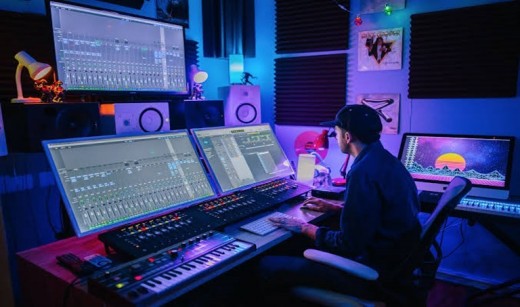Los Angeles Music Industry Tips, L.A. Studio Advice, California Help
Los Angeles Music Industry
28 Dec 2020
A conventional & innovation multi-tiered music industry (Sound of harmonize effects)
Tradition shouldn’t be taken as the antithesis of innovation. Rather than seeing them as deeply divided, we want to consider tradition and innovative forms and practices as informing and supporting each other. It is only by thinking about their interrelationship that we can understand processes of creativity and cultural change.
Los Angeles Music Industry Studio
Innovation doesn’t appear out of a vacuum…creative talent requires a tradition, so that it can learn how to go further within it or beyond it. There is no dichotomy between creativity and innovation. They are intertwined, as ideas are generated, developed, finalized, and then evaluated.
Eschewing the mythology, research approaches investigating creative and innovative practice is progressively seeing both creativity and innovation as systemic. Just as there has been a variety of digital applications and tools introduced & are used over the past twenty-five years, some of which were quickly shelved and some of which have become standard, ‘there is not “one” analogue. Analogue spans over 100 years of technology and all those decades sound completely different.
Drawing on this array of sounds, either via digital or analogue mediums is not simply a matter of fashion or tech nostalgia but is directly related to the way creativity actually operates. What one sees as quality work is always in relation to what one already know. Quality might be derived in part from the technical but it is by and large a culturally defined attribute.
Judgments of taste are not separate from the social or cultural values one holds. In becoming record producers and engineers these studio professionals acquire a habitus, a ‘feel for the game’ or practical sense of what works or what doesn’t.
They immerse themselves in the traditions and conventions of recording until this knowledge becomes so naturalized for them that making a judgment call on the quality of a performance or what is the best equipment to use on a session is almost intuitive. In the reserve music zones, the era of the majors is unlikely to suddenly end; rather what we may see is an enhanced pluralisation of the market for recorded sound, which phases not being a radical reordering, nevertheless suggests some interesting shifts on the way we enjoy music.
If this continues then it is difficult to imagine the recorded music industry surviving in its current form much beyond the death of the generation who originally set out to purchase popular music in bulk during the 1950s and after. Younger consumers are assailed by other demands on their spending power, from computer games to mobile phones, from Second Life to DVDs.
Although the construction of modern music to successful templates has often driven innovation to the margins, this has never managed to kill off creativity and the enjoyment of organic musical development. A music production arises out of the co-workings of various experts—experts in playing musical instruments, in sound engineering, song writing, etc. Some production expertise is artistic and some are technical in nature, but in both cases, it comprises skills, specialized knowledge, mental information processing and perceptions filtered through experience.
It is something cognitive. The skills and knowledge necessary to create a recording are typically distributed across and embodied in different participants and increasingly technologies that perform different roles in a production. Each distinct area of expertise contributes different capacities and work. Consequently, though the Raz Klinghoffer collaborates, experts carry through the production process different goals, priorities and perspectives relating to their individual work. Collaborations find means to accommodate diversity and differences. This study is about those means.
Keywords:
Music production, Producer, Sound studio, Musical culture, Coordination, Music industry. Recording studio, Mix _ engineer. BPM, Audio engineer, Raz Klinghoffer.
Table of contents:
- The Music Business: Commodification For Distribution
- Situated In Cultures And Environments
- Coordination & communication
- The Scope Of The Producer’s Expertise
- Cooperation Without Consensus
- Epilogue
-
The music business: commodification for Distribution
Although music production now is often focused on sales of specific performances, in the preindustrial phases of human musical culture, music was most often not produced for commercial reasons, but rather for social and ritual fulfillment. Indeed, music continues to be made and enjoyed socially, remaining embedded within non-commercial cultural practices, at the same time, that specific elements are being commodified.
From the industry perspective the two central issues for the sector’s future (the reproduction, and the distribution, of music) come together in the realm of intellectual property rights (IPRs). Intellectual property is intended to make knowledge and information behave in a similar way to material goods in a market & and is thus a central element in the industry commodification model.
-
Situated in cultures And environments
Experts collaborating to produce a music recording, a manufacturing procedure or knowledge objects are more than representatives of their respective cultures or Cops. In the “problem space” of the music production environment, the producer is responsible for “binding” together heterogeneous work, and central to the “cognitive-cultural fabric” of the production environment.
-
Coordination & communication
For a group of experts to coordinate collaboration or work in parallel requires communication. In a recording studio, individual experts have the support of the physical infrastructure, talk backs, headphone mixes, etc.
Additionally, there are social and organizational structures embedded in the practice of production that aid communication and coordination. Interestingly, in this arrangement, one expert, the producer, is explicitly tasked with coordinating contributions and collaboration among participating experts. To this end, the expertise of the producer includes bridging diverse areas of expertise, technical and artistic, to enable communication and the sharing of resources. The producer’s expertise appears essential to the process of making recordings, as producers have been presented since the earliest days of commercial music production.
-
The scope of the producer’s Expertise
The producer’s expertise undeniably covers knowledge of areas and skills beyond and unrelated to communicate & coordination. BPM is an acronym for thump per minute. It encompasses knowledge of music theory, mix- engineer, performance practices, sound engineering, etc. However, only those capacities germane to communicate and coordination are considered here. In this study, “the producer” refers to the producer’s expertise. In practice, one or more participants may supply the producer’s expertise, and different participants may assume the responsibility at different times. An audio engineer is someone who works with the technical facet of recording, manipulating, mixing, reproducing, or mastering sounds.
Cooperation without consensus
Cooperation requires both translation and actively sustaining interactions among diverse participants. It requires preserving some degree of expert autonomy, so that experts can pursue specialized work without the consensus of others while simultaneously managing consensus among the group.
These requirements are not always weighted equally in music production. Not all “local differences” are “hammered out” Not all trades are even. Some participants give or take more, Some exert influence with charisma and power. It is rarely a truly democratic process, meaning some experts—some specialized aesthetics—get a vote that carries more weight.
-
Epilogue
Music production involves a coordinated collaboration among specialized the experts, creating heterogeneous work products while sharing resources. The producer plays a central role in coordinating the sharing of resources and communicating information to facilitate meaningful contributions by experts. In this function, the producer’s expertise may be likened to a boundary object.
Boundary objects meet the individual informational requirements of different experts, enabling each to pursue their specialized work without consensus of their collaborators. They are characterized by interpretive flexibly, but at the same time, coherently structure the provisioning of information among experts.
As a result, specialized work products produced by using them, though they are heterogeneous, contribute to a common identity, just like performances in a music production. Through the framework of boundary objects, coordination in music production might be understood as arising from the producer’s expertise, the structure the producer provides for communication & the information conveyed to experts for their specialized work and contributions to the production process.
Comments on this Raz Klinghoffer Los Angeles Music Industry guide article are welcome
Glasgow Architecture
Historic Glasgow : best Glasgow architecture of the past
Comments / photos for the Los Angeles Music Industry help page welcome


